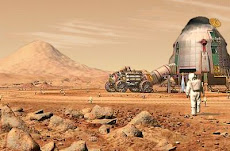
--------------------------------------------------------------------------------
Could the Tumbleweed Rover Dominate Mars?
By Ian O'Neill Thu Mar 4, 2010 08:22 PM ET
http://news.discovery.com/space/could-the-tumbleweed-rover-dominate-mars.html?print=trueTumbleweed probes exploring the Dao Vallis region of Mars. The inhospitable terrain is un-passable using conventional rovers, whereas a wind-blown Tumbleweed could traverse the gullies and debris to look for water and life (NASA LaRC/Case Western University/NASA Planetary Data System)
Before Mars can become the next great frontier for human exploration, we need to send more robotic missions to gather as much information as possible about our planetary neighbor. But what kind of robot has the right combination of weight, cost and range, while still being able to carry out groundbreaking science?
Cue the Tumbleweed Mars rover, an ingenious concept vying for attention in the hope of becoming an entirely different method to explore vast regions of the Martian surface, one that rolls across the surface instead of six-wheeling.
Orbiters, Landers, Rovers and... Tumbleweeds?
The robotic exploration of Mars has come in three shapes so far. First and foremost are the orbiters; satellites inserted in various Martian orbits, viewing the planetary surface with ever increasing resolution from hundreds of miles in altitude. Although they can't do science in situ, they can gain a global perspective on the Martian geography.
Then there are the landers; stationary probes carrying a suite of instruments to dig and analyze the local Martian dirt. They might be stuck on the spot, but they can do a lot of science.
A comparison of dust cover on NASA's Mars Expedition Rover Spirit's solar panels (NASA/JPL).And then there's the rover; a balance between mobility and scientific payload. Although there have only been three successful rover missions to date (two of which are still reporting for duty) and two more are planned for launch in the coming years, this is arguably the best way to trundle across the Martian surface. But even rovers have their limitations.
Complex moving parts (such as wheels and joints) get clogged or jammed, solar panels often get coated in dust and although their range can be impressive for an extraterrestrial robot, they can't really explore vast regions of Mars' surface. Opportunity is doing well, notching up kilometers on the odometer. Although Spirit is still soldiering on, the rover is firmly stuck in a sand trap in Gusev Crater.
(The upcoming Mars Science Laboratory Curiosity bypasses the solar array dust problem by using a radioisotope thermoelectric generator -- or RTG for short -- to power it. This car-sized rover will be able to dominate the Martian surface day, night and during the worst dust storms.)
A Short History of the Tumbleweed
So, before humans can explore where only robots have dared to tread, we need more reconnaissance missions with the ability to explore greater areas of the Martian landscape. This would be hugely beneficial for the continuing search for Martian life, as so far we've been restricted to only exploring tiny patches of Mars.
The robotic Tumbleweed could be the mission to fulfill these aims.
The idea of sending a spherical, wind-propelled vehicle (or "Mars Ball") to the Red Planet was originally conceived in 1977 by Jacques Blamont of NASA's Jet Propulsion Laboratory (JPL) and the University of Paris. This was shortly after the Mars Viking Landers discovered that the Martian atmosphere consisted mainly of carbon dioxide and had relatively strong winds. However, the modern incarnation of the Tumbleweed was inspired by accident.
The inflatable Mars Tumbleweed concept during tests in Antarctica in 2004 (Alberto Behar/NASA JPL)In 2000, another JPL team headed by Jack Jones was testing a three-wheeled inflatable rover in the Mojave Desert, Calif., when one of the "wheels" broke off and was blown over the sand dunes.
This inflatable ball bounced over boulders, sped up steep slopes and traveled over coarse vegetation with ease. As Jones' team chased after the oversized beach ball (measuring 1.5 meters in diameter), the idea was born: An independent ball that acts like a tumbleweed could have the potential to explore Mars, propelled only by the Martian winds.
HowStuffWorks: The Mars Tumbleweed gained its inspiration from its natural terrestrial counterpart, but how do tumbleweeds work?
To Rove or Roll?
But could this fascinating concept supersede the Mars rover as planetary exploration vehicle of choice? Let's face it, NASA's Mars Exploration Rovers have outlived their planned mission lifetimes by six years (they were designed to last five months). Why would we want to deviate from such a successful means of exploring this alien landscape?
"Spirit and Opportunity have been nothing short of spectacular. However, they have very limited mobility, which is often dictated by the terrain," Dr. Kim Kuhlman, Senior Research Scientist of the Planetary Science Institute, told Discovery News.
Kuhlman is one of the Tumbleweed scientists heading this effort to communicate the science behind this unique vehicle. She is scheduled to present the Mars Tumbleweed proposal at the Earth and Space 2010 conference in Hawaii on March 16.
"A fleet of Tumbleweeds could cover a much greater area using the wind for propulsion," she added. "Some of them may get stuck and become stationary platforms similar to Spirit's current situation, but the majority would perform a 'random-walk' survey of an area orders of magnitude greater than that of a rover."
The inflatable Tumbleweed concept being propelled by the Mars wind (NASA LaRC/Case Western University/NASA Planetary Data System) [Watch the video]But before this plan can advance beyond the concept phase, more funding is needed to develop the miniaturized instrumentation that would need to be carried aboard the Tumbleweeds. If researchers can get the funds, the physical size of scientific experiments could be shrunk, making them easier for the spherical probes to tote.
The Tumbleweeds are intended to track atmospheric conditions, geographical location, communicate with orbiters (to relay data back to Earth), and even probe the chemistry of Martian soil, so the smaller the better. They could even generate their own power by harnessing the kinetic energy their motion generates.
There's also the tantalizing possibility that a fleet of Tumbleweeds -- each with different instruments on board -- could "swarm" and act as one unit to carry out a sophisticated array of measurements.
"The instrumentation is constantly being miniaturized and some components could actually come off the shelf. The real constraining factor as to how many and which instruments are deployed is the amount of power that can be incorporated. Batteries add mass, which slows down the Tumbleweed. One can certainly envision a fleet of Tumbleweeds that have various configurations of instruments and the capability to swarm if one Tumbleweed finds something of great interest. This would, of course, require a means of controlling the direction of movement of the Tumbleweeds. This technology is not very mature because funding has not been available." -- Kim Kuhlman.
They Come in All Shapes and Sizes
If the project is given the go-ahead, NASA will need to decide what configuration of Tumbleweed would be most efficient and/or practical.
For example, the inflatable Tumbleweed concept is a tried and tested vehicle, having undergone extensive field tests in Greenland and Antarctica in 2003 and 2004. The inflatable Tumbleweed traversed hundreds of miles while continually relaying atmospheric measurements and location data.
Miniature sensor platforms could be dropped by the Tumbleweed to further investigate a location of special interest while the Tumbleweed continues on its way (NASA LaRC/Case Western University/NASA Planetary Data System)
[Watch the video]It is also hoped the inflatable design could be commanded to deflate at locations of interest, causing it to "sit down" and stop rolling. As the underside will be in greater contact with the ground, perhaps analysis tools can be lowered into the cavity beneath, sampling any gases vented from the ground. (Watch the video to see the inflatable Tumbleweed in action.)
Another prominent Tumbleweed design is a ridged "box kite" type. Although this technique is less mature than the inflatable design, the sail-like paddles have a better drag coefficient. This means they will use the available Mars winds more efficiently, perhaps traveling further and faster.
To aid control over the Tumbleweed, an offset weight housed in the center of the sphere could be commanded to alter position, shifting the Tumbleweed's center of mass and essentially steering it that way.
These concepts, along with others -- namely the Dandelion, Eggbeater, and Tumble-cup configurations -- have been tested and developed by a collaboration of research institutions including NASA Langley Research Center, North Carolina State University, Texas Tech University, the Biorobotics Laboratory at Case Western Reserve University and Planetary Science Institute.
Ready to Roll?
Although we probably won't see a fleet of Tumbleweeds bouncing across the Martian surface any time soon, it is certainly a novel approach to planetary exploration. However, Kuhlman will have her work cut out to convince the world that this paradigm shift in robotic exploration is a viable one.
"I've actually had a very influential scientist in astrobiology call the idea "loopy" to my face," she added.
But critics be warned, the Tumbleweed scientists have been working on this project for a decade and Kuhlman is lead author of a chapter titled "Tumbleweed: A New Paradigm for Surveying the Surface of Mars for In-situ Resources" of the book Mars: Prospective Energy and Material Resources.















